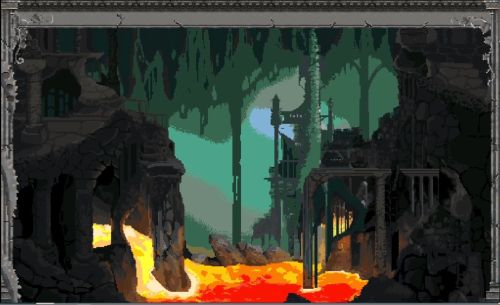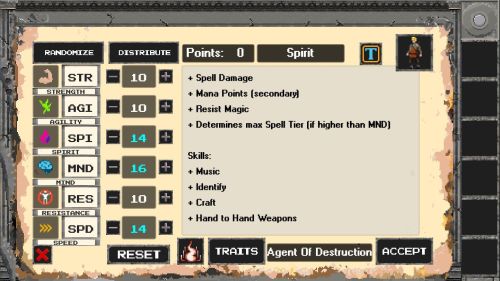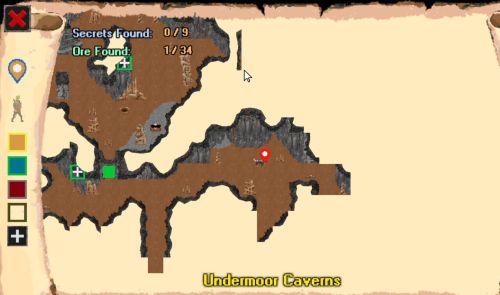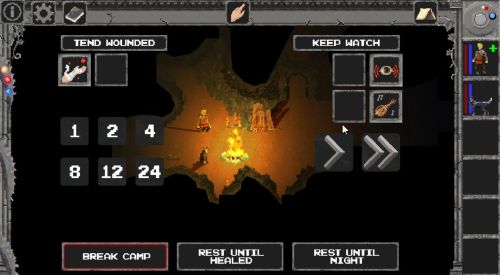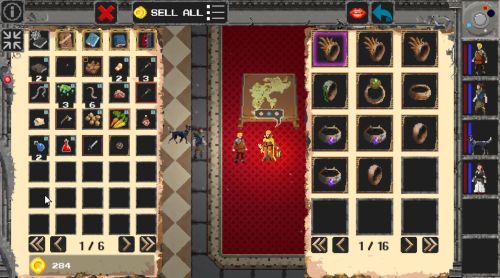RPG Codex Review: Caves of Lore
RPG Codex Review: Caves of Lore
Codex Review - posted by Infinitron on Sat 10 June 2023, 23:26:11
Tags: Caves of Lore[Review by Kalarion]
INTRODUCTION
Caves of Lore is an isometric, turn- and party-based indie RPG, with retro-pixel graphics, developed solo by Mike Robins (Codex username LoreMaster) over the course of ~6 years. You play as a shepherd who goes looking for a lost sheep in a mysterious mist, causing you to fall into the eponymous caves, which is the start of your adventure.
Caves of Lore features tactical, square-tiled combat with a party of up to 6 members. Character development is primarily skill-based, with feats available through a unique (as far as I am aware) mechanic. Exploration incorporates time through the use of a lunar system that can affect the game world. Dialogue is keyword-based, with new keywords becoming universally available as appropriate.
THE WORLD AND LORE
There's a lot going on in the world of Solmaria, where your adventure takes place. When you begin play you're part of the only known village left in the world, cut off from everywhere else by a mist that saps memories from those who walk through it. Everything - and I mean everything - is more than what it seems, if only because everyone seems to be losing all their memories at a varying pace. As the game progresses you'll discover more about what is happening now, and the several-millennia-long history of Solmaria.
Throughout the game you will discover books, all of which can be read for various effects. Some provide snippets of the world's history, some provide clues to items and interactions available in the game, some grant the use of spells, and some when read will grant a one-time bonus to a given skill for the entire party. This is one of the few games I've played in the last two decades that I would say makes every in-game book or note worth reading. There are three primary reasons: certain gameplay and plot advancement elements are unlocked through reading notes, scrolls, books etc; the lore of the world is actually interesting; and no book or note will take longer than 3 minutes to read. There is no distracting word-vomit here. Not everything read is useful for gameplay, but I actually enjoyed reading new books and scraps of paper, a rare accomplishment for a game.
For the lore itself I note again that this is the first game in a long time to make me genuinely interested in the world's history. Primarily my interest arose from small opportunities to interact with that history through gameplay. Every map has at least one or two secrets that are callbacks to journal pages, books or conversations with NPCs. And almost all of those interactions, when successfully completed, reward the player, usually very well indeed.
STORY
You play as a shepherd, determined to find a sheep that has wandered off into the fog surrounding your village. The mist seems to cause you to lose memories, eventually resulting in your wandering aimlessly. You forget everything except the fact you're looking for a lost sheep. Eventually you come upon a black cat, whose presence lures you into falling down a steep chasm, at the bottom of which is a friendly dog. At this point, you take control of your character and a short tutorial area begins. You gain an old, musty tome, simply labeled "Codex" ( ), which seems to restore some of your memories and clarity of thought, and a spell book which gives you access to your first exploration-related spells. With the aid of the spells and some help from your new dog, you begin exploring your surroundings.
), which seems to restore some of your memories and clarity of thought, and a spell book which gives you access to your first exploration-related spells. With the aid of the spells and some help from your new dog, you begin exploring your surroundings.
What starts as an attempt to find your way back to the surface, and your village, quickly turns into much more. You come across an underground citadel which is curiously intact despite showing signs of great age. A small group of people are sheltering inside, protected somehow from further memory loss, but unable to leave. After finding a possible route to your village on the surface, you are confronted by a grotesquely mutated rat, who makes reference to the return of a "Dark Lord". Your small party decides to determine if this lord has anything to do with the mists, the loss of memories... and perhaps the black cat which lured you into the caves in the first place.
You'll find your way back to the village in short order, at which point the game world opens up a little. You'll have several options for further exploration. Fully the first half of the game is devoted to gaining access to the village library (locked, with the key thrown away by the town's Mayor), in order to conduct further research on the dark lord. But as stated earlier, everything is more than it seems. The library isn't just a library. The village of Emerisk appears to have once been so much more, as were all of its inhabitants. It was built on top of the ruins of an ancient city, with the citadel as its centerpiece, in turn built on top of yet more ruins.
New questions about Solmaria's history and inhabitants are brought forth throughout the game. Who else shares the world with the lonely and isolated villagers and citadel inhabitants? What is trying to harvest your people, and what is being harvested? Who is this dark lord, where has he been until now, and what stirred him to activity? How is it that a small village in the middle of nowhere houses an enormous and foreboding library? What happened to its librarian? What is going on with that cat?!
The storyline as such does a competent job of hooking the player into the game. All these open questions demand answers, and the slowly revealed history of the world is fun to explore. Caves of Lore's great strength here is a relentless drive to tie history and story into gameplay, as described above. I might have had a very different opinion of all this "story lore" if I'd been forced to read huge volumes of textual diarrhea, pulling me out of actually playing the game. Thankfully I wasn't. You're going to have to read at least a little to progress the game, but the great majority of it is entirely optional. Everything comes in easily digestible chunks, and as far as the main story path is concerned, progression is clearly spelled out where appropriate.
THE PARTY
Your party can contain up to six active characters, one of which will always be the main character. Characters come with pre-set stats, a unique (though not necessary except in one case) exploration ability, and two unique combat abilities which can be "upgraded" once each (learning a new, usually more powerful ability) with mastery (more on that later). They have their own backgrounds and motivations, and all can be spoken with, either in the main hub of the game (the underground/overground town of Kalindraur/Emerisk) while idle, or during camping breaks.
Character personalities are pretty predictable. There is minimal party banter during important events, but overall nothing to write home about. The plethora of available characters and their wide range of attribute specializations, exploration abilities and combat abilities means there's something for everyone. It's fairly easy to tailor your party to your taste. The notable exception is a character received very late in the game via an unusual method, whose exploration ability is absolutely and uniquely critical to unlocking all of the secrets in the game (as it reveals certain things which can't be discovered in any other way, as far as I know).
CHARACTER DEVELOPMENT
The Caves of Lore character system is a mix of attributes, skills and feats. You create the main character by setting his attributes using a point-buy system that will be familiar to any modern CRPG player. Each attribute can be raised for an escalating number of points. You also select one feat which gives a bonus to a specific weapon or spell category.
Attributes primarily work by modifying various skills. Equipment and spells may also have minimum attribute requirements in order to use them effectively, or at all. Attributes do not increase much throughout the game. They are primarily raised permanently through the discovery of special in-game locations, and temporarily through the use of music at camping and from item enchantment bonuses.
Skills are the primary method of determining the outcome of all in-game actions. There are 15 general skills, available to all characters. Each spell and ability has a skill level. Finally, each character has access to two unique abilities which are also skills. Increasing the skill level has predictable effects, with increased damage, area of effect, duration and so forth as a skill goes up. Skills are primarily increased by using them; swinging a one-handed sword increases the One-Handed weapon skill, while attempting to disarm a trap or pick a lock will increase the Disarm skill. Spells, too, increase in level through use. Skills can also be increased through the distribution of "free" skill points, gained at level up.
Spells and abilities (both generic and character-specific) can be mastered (denoted by a purple square outline around the skill icon) by attaining a skill level specific to each spell/ability, granting a unique one-time bonus. Mastered spells can be cast without the use of associated spellbooks, while the character-specific abilities grant access to one new ability each upon mastery.
As a general rule I am not a fan of character development that focuses heavily on learn-by-doing, and this game is no exception. The idea of certain skills slowly improving over time based on what you enjoy doing is fine in theory; in practice, I often had to force myself to use skills and spells I cared nothing about for various reasons (primarily spell mastery of useful spells). The drudge of mastery and simply raising, say, combat skills, is exacerbated by the fact that later characters don't start with a large skill investment when recruited to the party. Using them in place of characters you've had from the beginning of the game can be extraordinarily painful, especially in the case of one character who is clearly designed to be a powerful mage, but starts with absolutely no mastered spells, and only a deceptively large pool of unspent skill points (which again, in practice, doesn't amount to nearly the skill levels of party members who have been with you from the start). Getting this character to even a basic functional ability with spells, and replacing the lost general skill coverage from previous characters, hurts, a lot.
The game does provide you the ability to train characters who aren't in the party in the use of spells and weapon skills, but only one spell or skill at a time per character.
On the other hand, the mechanics themselves are pretty fun in moderation, with a nice bonus bestowed for mastering spells and character abilities. Scaling power means your favorite spells and abilities also remain useful throughout the game, provided you use them continuously. And certain spells become much more useful with skill, making exploration and world navigation more comfortable. On the whole learn-by-doing could have benefited from a little pruning of the -doing part, and an eye towards easing the process of bringing new characters up to speed as they're recruited.
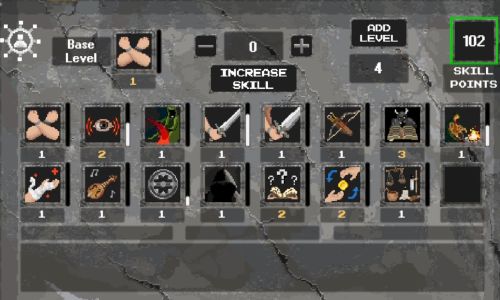
The general skill screen, covering everything from combat styles to camping and bartering.
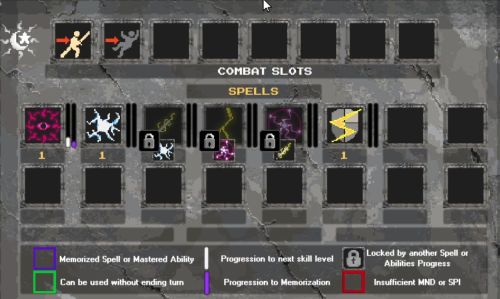
Spells, similar to the ability screen. Note the thumbnail image for prerequisite spells under locked icons.
You gain levels with experience, obtained from successful combat and by completing quests. Each level grants an increasing tranche of discretionary skill points, which can be distributed to any of the general skills (but not to abilities or spells). At each 2nd and 3rd level you also gain an additional available feat, and a new combat ability respectively.
Abilities are acquired in two ways. First, each character starts with two unique abilities. When mastered, they grant access to one (and only one) new ability each (usually a direct upgrade, but sometimes simply a more powerful ability of the same "flavor"), for a total of four unique abilities per character. Unique abilities range from powerful multi-hit skills (such as the abilities of the main character), to buffing and debuffing, to character and monster positioning skills. There's a lot of variety between characters, and their abilities are generally useful enough that you're always incentivized to use them in combat when applicable (if for no other reason than to see what the unlocked abilities will do!).
Second, abilities are gained through leveling up, every third level. This pool is shared between all characters, and also features a decently wide range, but most of them focus on buffing standard actions (adding piercing to ranged attacks, increasing to-hit chance, adding a chance to stun, supercharging spells and so forth). They're nice in theory but in practice I rarely had need for them, especially after I started unlocking the second tier of unique character abilities. I suspect they would find much more use in a playthrough on higher difficulty levels.
Feats are acquired solely through leveling up, every other level. Feat points can be stored to await more powerful feats if desired. They start very generic and gradually become varied and specialized, with later feats tying their strength to, say, the moon phase or time of day. In theory this could encourage making considerations of time etc a big part of selecting when to start combat. In practice most times such feats just gave a nice unexpected bonus when initiating combat under the correct circumstances. Still, the variety was much appreciated.
Finally a word must be said about the acquisition of feats, in my opinion the coolest overall aspect of character development. Each monster has its own lore entry, filled gradually by fighting that monster in combat. Entries are filled at a speed dependent on each character's Monster Lore skill, which makes getting everyone to at least basic competence (10+) in Monster Lore a good idea, if not strictly necessary. Each monster grants access to a new feat for purchase on levelup after a certain threshold of information is passed in its lore entry. As far as I know this is the only game that ties learning monsters' strengths and weaknesses (and actively seeking out encounters with rarer monsters) directly to in-game power (rather than meta-power), and I love it. It's a lot of fun to suddenly see new sets of feats available on character levelup, and it also gently nudges players to pay attention to each monster's lore entry, encouraging them to learn each monster's strengths and weaknesses. In turn players can expect to be able to take on much more challenging difficulty levels. It's the smoothest challenge-ramping encouragement and reward mechanic I can remember playing with, and very satisfying.
COMBAT
Caves of Lore's combat is carried out on a separate, 6x14 square-tiled grid. In almost all cases, your characters will start in up to four rows on the left side of the grid, and monsters will start in varying positions on the right side. Combat is turn-based, with each participant rolling initiative at the start of battle to determine turn order for the rest of the fight. The sole exception I've seen is being ambushed while camping (extraordinarily rare), which causes your characters to start in the middle of the grid surrounded by the monsters that ambushed you.
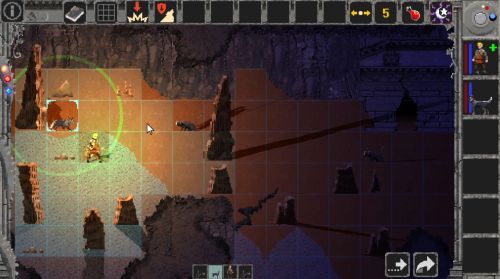
Your first combat, against the standard and ubiquitous Giant Rat(s). Note the turn order queue at the bottom of the screen.
You have a limited ability to control your turn order through the use of a wait command, which will move you one spot in the turn queue. However in practice this is sometimes useless. If you have two characters you desire to hold through monster movement, they'll end up waiting one turn and continuously giving each other the next spot in the queue, switching back and forth.
Each character has a set number of movement points determined by speed, and is allowed to take one full-turn action which will end his turn. Certain actions (such as the musical effects from a specific character's unique abilities) will not end your turn, generally allowing small pre-buffs or setups for normal actions (attacking, spellcasting etc).
I very much appreciate the style of combat (turn-based, grid-based), and the variety of actions and enemies available. I never got bored with combat during my playthrough. However there are some problems in execution, some of which are very frustrating.
Pathfinding in combat is unpredictable and sometimes dangerous or fatal, especially for ranged characters. Never, ever, ever, ever click-to-attack with a ranged character when the desired target is outside of attack range and/or LOS (if you can determine LOS, see below), even if in theory the character has the movement available to get in range. Always click to move into range first, then click to attack. I have had multiple instances of ranged characters using bizarre routes to get into attack range, sometimes walking directly next to their targets prior to attacking. In the case of one particularly fragile character this is almost without exception fatal. Even moving without attacking can sometimes result in highly unintuitive routes, resulting in wasted movement points and, occasionally, failure to reach spots that are clearly in movement range (due to a zig-zagging path taken when attempting to reach it).
I also found the presentation of obstacles and determination of line-of-sight to be confusing and occasionally frustrating. Objects which look like they should block LOS or movement may not. Characters and monsters are sometimes able to occupy the same space as what appear to be blocking props on the map (large stalactites, statues etc). Props which look like they should block skills sometimes don't, and vice versa. The dev has made admirable progress in clearing out a great deal of the jank from this game post-launch, but clearly communicating movement and LOS, and predictable pathfinding are two areas with a notable lack of progress. At no point did these issues cause me a quitting level of frustration, but they were very much felt.
Overall combat is functional and enjoyable, with a large variety of skills and monsters, and a much-appreciated 6-man party granting a wide set of options. Just remember to remain vigilant against the game's pathfinding and have some patience to work through LOS and movement-blocking use-cases.
EXPLORATION
Caves of Lore features isometric movement and exploration over a gradually-expanding range of maps. It is not open-world, but each area is expansive enough (and in many cases, revisited enough) that it never felt restrictive or predictable. Exploration is distinguished by the game's lunar system, which tracks the position of the game's three moons and sun. Each moon, or combination, can have various effects depending on their position and the time of day. The effects range from combat, granting bonuses to spells and skills and activating certain feats, to exploration, opening up new paths and unlocking secret areas or treasures.
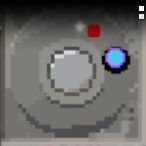
The sundial. Figuring this sucker out and properly mastering its use is frustrating, fun and very rewarding.
The game also has an in-game automap, filled in as you explore. There is just enough detail on the automap to jog your memory and aid you when trying to recall bits and pieces of unfinished puzzles, without being so explicit that it gives the game away. The automap also allows for an (as far as I know) undocumented auto-travel feature, useful when backtracking or moving about in town and so forth. It also keeps track of how many of each area's secrets and ores you've discovered. Normally I wouldn't appreciate such a tracker, but in this case, with the myriad secrets and some uncertainty about whether the doodads on the map are actually used in the game or not, I didn't mind it too much.
Let's get this out of the way now: I'm a huge fan of this game's exploration mechanics, and I believe it is by far its most enjoyable aspect. You never feel bored wandering around. There are always new areas to explore, or old areas with expanded avenues opening up, or interesting opportunities to interact with the environment. Discovering the mechanics behind the game's lunar system is the best kind of joy: frustrating at first, then deeply satisfying once you've attained mastery. And since treasure unlocked via lunar mechanics is by far the best in the game, it's always a huge rush to figure out a given puzzle. Learning the little peculiarities of each type of puzzle was also fun and satisfying.
For those (like me) who had a difficult time figuring out the lunar system solely through in-game experimentation, there are a series of books giving more detailed explanations, while still leaving room for further discovery, and several spells which are solely exploration-related to expand options as the game progresses.
Camping is conducted anywhere with enough room to seat your party of characters. You have a range of jobs which can be performed during camp, as well as some options for passing time, both in terms of hours/days and moon phase. Your hp and mana will regen while encamped, dependent on each character's Survival skill.
A few sour notes detract from the overall experience. First, a game tied to a lunar system which depends on the passage of time necessarily entails a lot of time spent waiting in the game (usually via camping). You're going to spend a lot of time staring at the game's sundial while encamped if you want to unlock every secret. I'm not sure how to solve this problem (or even if it's wise to mess with it), since the feeling of time passing is tied so tightly into exploration.
Second, one character's exploration ability is absolutely required in order to unlock several secrets, which does not in my opinion fit with the other characters' theme of "useful but not necessary" exploration abilities. In particular there is a great deal of pressure placed on the player to conduct a ton of grinding in order to bring this character up to speed with the rest of the party, so he can be useful to the party in combat (which also ties back to the character development issues talked about earlier).
Finally, camping is effectively a risk-free refill mechanic. The only potential throttle is the possible amount of time required to completely refill the mana of mage characters. Especially at higher levels it's usually faster to stay the night at the inn or dormitory since it instantly refills health and mana overnight. The developer recently added the ability for nearby monsters to ambush you while encamped, but practically speaking you will only risk this happening if you camp right on top of a monster (within a couple tiles).
Still, I cannot emphasize enough how happy I've been to enjoy exploration so much. As I've commented elsewhere, I don't remember the last time I looked forward so eagerly to finding out what's just around the corner. Maybe the Exiles, from when I was a teenager. A very impressive feat, and the developer deserves major kudos.
INVENTORY MANAGEMENT, BUYING AND SELLING, AND NPC SERVICES
The inventory in Caves of Lore is standard fare, with an expandable paged grid, each item taking up one grid slot. Items can be sorted by type, in a customizable order, with the type selected being placed at the top of the inventory. Containers of varying sizes are scattered throughout the game, which can aid in keeping items organized.
Buying and selling also works as expected, conducted via a functional interface. Shops discovered in the game's main town of Emerisk will drop a "Shop" sign on entrance, which can be clicked on to go directly to the relevant NPC's shopping inventory in lieu of finding the NPC himself and talking. Expanding this functionality to all shopkeepers in the game would be much appreciated, but overall shopping works fine.
Some NPCs also provide special services, such as training skills, enchanting and forging, which can be accessed via the same interface. Enchantments can be stripped from magic items and stored for later placement on another item of your choice. They can also be strengthened, enhancing the bonus for a given enchantment. Each operation costs a certain amount of Manatite, with the cost increasing concomitant with the power of the enchantment. Forging works much the same way, using various metals to bestow a small range of properties to a given weapon or piece of armor.
I didn't bother too much with forging or enchanting (a by-product of - perhaps foolishly - never increasing the difficulty beyond Normal), but the possibilities are pretty enticing. The interesting part here is that the "enchantment" from forging can also be strengthened, via repeated forging with the same metal. For instance, Silver makes a weapon effective against Undead and Arcane monsters, but it also lowers the strength requirement for equipment. If you're willing to spend additional Silver, you can drastically lower the strength requirement, say to allow a mage character to wield a desired 2-handed weapon or piece of body armor. This works for each metal effect.
The system overall is interesting and I had fun customizing my weapons and armor to the limited extent that I used it.
The inventory itself has had the most obvious work and progress post-release, but some glaring frustrations still remain, on par with combat issues. It is now possible to use a "Sort All" function, which works loosely (but not completely) as you would expect in any other game with a sprawling, perpetually bloated inventory. Yet finding items, sorting, buying and selling, and enchanting still have rough edges which makes dealing with your equipment and other items always feel like a low-level chore. On my first playthrough I consciously avoided interacting with the inventory to the maximum extent possible. As I said, a great deal of that early frustration has been ameliorated via continuous patched functionality. But there's still lots of room for improvement here.
CLOSING THOUGHTS AND RATING
The game closes a little abruptly, with an ending that makes it obvious a sequel is planned. I clocked in about 45 hours of playtime, a significant portion of which (probably a good 5 hours) was spent in the camp interface waiting on various moon phases. Yet the plethora of secrets, wide range of character development options, and the many areas of the game where I know there's more to discover mean I have already started a new playthrough. Needless to say I look forward to any sequels.
Caves of Lore is easily my favorite RPG played this year, and ranks up in the top 20, at least, of my favorite RPGs played ever. Distinguished by its excellent exploration mechanics, Caves of Lore was a contender for Game of the Year for me even before the continuous work put in post-release by the developer. After the many bugfixes, improvements and quality-of-life additions, Caves of Lore is easily my choice for Game of the Year. It's an outstanding addition to the ranks of both the CRPG genre and the efforts of indie developers. Mike Robins aka LoreMaster deserves praise and appreciation for his work, and it is my devout hope that he will continue making CRPGs well into the future.
INTRODUCTION
Caves of Lore is an isometric, turn- and party-based indie RPG, with retro-pixel graphics, developed solo by Mike Robins (Codex username LoreMaster) over the course of ~6 years. You play as a shepherd who goes looking for a lost sheep in a mysterious mist, causing you to fall into the eponymous caves, which is the start of your adventure.
Caves of Lore features tactical, square-tiled combat with a party of up to 6 members. Character development is primarily skill-based, with feats available through a unique (as far as I am aware) mechanic. Exploration incorporates time through the use of a lunar system that can affect the game world. Dialogue is keyword-based, with new keywords becoming universally available as appropriate.
THE WORLD AND LORE
There's a lot going on in the world of Solmaria, where your adventure takes place. When you begin play you're part of the only known village left in the world, cut off from everywhere else by a mist that saps memories from those who walk through it. Everything - and I mean everything - is more than what it seems, if only because everyone seems to be losing all their memories at a varying pace. As the game progresses you'll discover more about what is happening now, and the several-millennia-long history of Solmaria.
Throughout the game you will discover books, all of which can be read for various effects. Some provide snippets of the world's history, some provide clues to items and interactions available in the game, some grant the use of spells, and some when read will grant a one-time bonus to a given skill for the entire party. This is one of the few games I've played in the last two decades that I would say makes every in-game book or note worth reading. There are three primary reasons: certain gameplay and plot advancement elements are unlocked through reading notes, scrolls, books etc; the lore of the world is actually interesting; and no book or note will take longer than 3 minutes to read. There is no distracting word-vomit here. Not everything read is useful for gameplay, but I actually enjoyed reading new books and scraps of paper, a rare accomplishment for a game.
For the lore itself I note again that this is the first game in a long time to make me genuinely interested in the world's history. Primarily my interest arose from small opportunities to interact with that history through gameplay. Every map has at least one or two secrets that are callbacks to journal pages, books or conversations with NPCs. And almost all of those interactions, when successfully completed, reward the player, usually very well indeed.
STORY
You play as a shepherd, determined to find a sheep that has wandered off into the fog surrounding your village. The mist seems to cause you to lose memories, eventually resulting in your wandering aimlessly. You forget everything except the fact you're looking for a lost sheep. Eventually you come upon a black cat, whose presence lures you into falling down a steep chasm, at the bottom of which is a friendly dog. At this point, you take control of your character and a short tutorial area begins. You gain an old, musty tome, simply labeled "Codex" (
What starts as an attempt to find your way back to the surface, and your village, quickly turns into much more. You come across an underground citadel which is curiously intact despite showing signs of great age. A small group of people are sheltering inside, protected somehow from further memory loss, but unable to leave. After finding a possible route to your village on the surface, you are confronted by a grotesquely mutated rat, who makes reference to the return of a "Dark Lord". Your small party decides to determine if this lord has anything to do with the mists, the loss of memories... and perhaps the black cat which lured you into the caves in the first place.
You'll find your way back to the village in short order, at which point the game world opens up a little. You'll have several options for further exploration. Fully the first half of the game is devoted to gaining access to the village library (locked, with the key thrown away by the town's Mayor), in order to conduct further research on the dark lord. But as stated earlier, everything is more than it seems. The library isn't just a library. The village of Emerisk appears to have once been so much more, as were all of its inhabitants. It was built on top of the ruins of an ancient city, with the citadel as its centerpiece, in turn built on top of yet more ruins.
New questions about Solmaria's history and inhabitants are brought forth throughout the game. Who else shares the world with the lonely and isolated villagers and citadel inhabitants? What is trying to harvest your people, and what is being harvested? Who is this dark lord, where has he been until now, and what stirred him to activity? How is it that a small village in the middle of nowhere houses an enormous and foreboding library? What happened to its librarian? What is going on with that cat?!
The storyline as such does a competent job of hooking the player into the game. All these open questions demand answers, and the slowly revealed history of the world is fun to explore. Caves of Lore's great strength here is a relentless drive to tie history and story into gameplay, as described above. I might have had a very different opinion of all this "story lore" if I'd been forced to read huge volumes of textual diarrhea, pulling me out of actually playing the game. Thankfully I wasn't. You're going to have to read at least a little to progress the game, but the great majority of it is entirely optional. Everything comes in easily digestible chunks, and as far as the main story path is concerned, progression is clearly spelled out where appropriate.
THE PARTY
Your party can contain up to six active characters, one of which will always be the main character. Characters come with pre-set stats, a unique (though not necessary except in one case) exploration ability, and two unique combat abilities which can be "upgraded" once each (learning a new, usually more powerful ability) with mastery (more on that later). They have their own backgrounds and motivations, and all can be spoken with, either in the main hub of the game (the underground/overground town of Kalindraur/Emerisk) while idle, or during camping breaks.
Character personalities are pretty predictable. There is minimal party banter during important events, but overall nothing to write home about. The plethora of available characters and their wide range of attribute specializations, exploration abilities and combat abilities means there's something for everyone. It's fairly easy to tailor your party to your taste. The notable exception is a character received very late in the game via an unusual method, whose exploration ability is absolutely and uniquely critical to unlocking all of the secrets in the game (as it reveals certain things which can't be discovered in any other way, as far as I know).
CHARACTER DEVELOPMENT
The Caves of Lore character system is a mix of attributes, skills and feats. You create the main character by setting his attributes using a point-buy system that will be familiar to any modern CRPG player. Each attribute can be raised for an escalating number of points. You also select one feat which gives a bonus to a specific weapon or spell category.
Attributes primarily work by modifying various skills. Equipment and spells may also have minimum attribute requirements in order to use them effectively, or at all. Attributes do not increase much throughout the game. They are primarily raised permanently through the discovery of special in-game locations, and temporarily through the use of music at camping and from item enchantment bonuses.
Skills are the primary method of determining the outcome of all in-game actions. There are 15 general skills, available to all characters. Each spell and ability has a skill level. Finally, each character has access to two unique abilities which are also skills. Increasing the skill level has predictable effects, with increased damage, area of effect, duration and so forth as a skill goes up. Skills are primarily increased by using them; swinging a one-handed sword increases the One-Handed weapon skill, while attempting to disarm a trap or pick a lock will increase the Disarm skill. Spells, too, increase in level through use. Skills can also be increased through the distribution of "free" skill points, gained at level up.
Spells and abilities (both generic and character-specific) can be mastered (denoted by a purple square outline around the skill icon) by attaining a skill level specific to each spell/ability, granting a unique one-time bonus. Mastered spells can be cast without the use of associated spellbooks, while the character-specific abilities grant access to one new ability each upon mastery.
As a general rule I am not a fan of character development that focuses heavily on learn-by-doing, and this game is no exception. The idea of certain skills slowly improving over time based on what you enjoy doing is fine in theory; in practice, I often had to force myself to use skills and spells I cared nothing about for various reasons (primarily spell mastery of useful spells). The drudge of mastery and simply raising, say, combat skills, is exacerbated by the fact that later characters don't start with a large skill investment when recruited to the party. Using them in place of characters you've had from the beginning of the game can be extraordinarily painful, especially in the case of one character who is clearly designed to be a powerful mage, but starts with absolutely no mastered spells, and only a deceptively large pool of unspent skill points (which again, in practice, doesn't amount to nearly the skill levels of party members who have been with you from the start). Getting this character to even a basic functional ability with spells, and replacing the lost general skill coverage from previous characters, hurts, a lot.
The game does provide you the ability to train characters who aren't in the party in the use of spells and weapon skills, but only one spell or skill at a time per character.
On the other hand, the mechanics themselves are pretty fun in moderation, with a nice bonus bestowed for mastering spells and character abilities. Scaling power means your favorite spells and abilities also remain useful throughout the game, provided you use them continuously. And certain spells become much more useful with skill, making exploration and world navigation more comfortable. On the whole learn-by-doing could have benefited from a little pruning of the -doing part, and an eye towards easing the process of bringing new characters up to speed as they're recruited.

The general skill screen, covering everything from combat styles to camping and bartering.

Spells, similar to the ability screen. Note the thumbnail image for prerequisite spells under locked icons.
Abilities are acquired in two ways. First, each character starts with two unique abilities. When mastered, they grant access to one (and only one) new ability each (usually a direct upgrade, but sometimes simply a more powerful ability of the same "flavor"), for a total of four unique abilities per character. Unique abilities range from powerful multi-hit skills (such as the abilities of the main character), to buffing and debuffing, to character and monster positioning skills. There's a lot of variety between characters, and their abilities are generally useful enough that you're always incentivized to use them in combat when applicable (if for no other reason than to see what the unlocked abilities will do!).
Second, abilities are gained through leveling up, every third level. This pool is shared between all characters, and also features a decently wide range, but most of them focus on buffing standard actions (adding piercing to ranged attacks, increasing to-hit chance, adding a chance to stun, supercharging spells and so forth). They're nice in theory but in practice I rarely had need for them, especially after I started unlocking the second tier of unique character abilities. I suspect they would find much more use in a playthrough on higher difficulty levels.
Feats are acquired solely through leveling up, every other level. Feat points can be stored to await more powerful feats if desired. They start very generic and gradually become varied and specialized, with later feats tying their strength to, say, the moon phase or time of day. In theory this could encourage making considerations of time etc a big part of selecting when to start combat. In practice most times such feats just gave a nice unexpected bonus when initiating combat under the correct circumstances. Still, the variety was much appreciated.
Finally a word must be said about the acquisition of feats, in my opinion the coolest overall aspect of character development. Each monster has its own lore entry, filled gradually by fighting that monster in combat. Entries are filled at a speed dependent on each character's Monster Lore skill, which makes getting everyone to at least basic competence (10+) in Monster Lore a good idea, if not strictly necessary. Each monster grants access to a new feat for purchase on levelup after a certain threshold of information is passed in its lore entry. As far as I know this is the only game that ties learning monsters' strengths and weaknesses (and actively seeking out encounters with rarer monsters) directly to in-game power (rather than meta-power), and I love it. It's a lot of fun to suddenly see new sets of feats available on character levelup, and it also gently nudges players to pay attention to each monster's lore entry, encouraging them to learn each monster's strengths and weaknesses. In turn players can expect to be able to take on much more challenging difficulty levels. It's the smoothest challenge-ramping encouragement and reward mechanic I can remember playing with, and very satisfying.
COMBAT
Caves of Lore's combat is carried out on a separate, 6x14 square-tiled grid. In almost all cases, your characters will start in up to four rows on the left side of the grid, and monsters will start in varying positions on the right side. Combat is turn-based, with each participant rolling initiative at the start of battle to determine turn order for the rest of the fight. The sole exception I've seen is being ambushed while camping (extraordinarily rare), which causes your characters to start in the middle of the grid surrounded by the monsters that ambushed you.

Your first combat, against the standard and ubiquitous Giant Rat(s). Note the turn order queue at the bottom of the screen.
Each character has a set number of movement points determined by speed, and is allowed to take one full-turn action which will end his turn. Certain actions (such as the musical effects from a specific character's unique abilities) will not end your turn, generally allowing small pre-buffs or setups for normal actions (attacking, spellcasting etc).
I very much appreciate the style of combat (turn-based, grid-based), and the variety of actions and enemies available. I never got bored with combat during my playthrough. However there are some problems in execution, some of which are very frustrating.
Pathfinding in combat is unpredictable and sometimes dangerous or fatal, especially for ranged characters. Never, ever, ever, ever click-to-attack with a ranged character when the desired target is outside of attack range and/or LOS (if you can determine LOS, see below), even if in theory the character has the movement available to get in range. Always click to move into range first, then click to attack. I have had multiple instances of ranged characters using bizarre routes to get into attack range, sometimes walking directly next to their targets prior to attacking. In the case of one particularly fragile character this is almost without exception fatal. Even moving without attacking can sometimes result in highly unintuitive routes, resulting in wasted movement points and, occasionally, failure to reach spots that are clearly in movement range (due to a zig-zagging path taken when attempting to reach it).
I also found the presentation of obstacles and determination of line-of-sight to be confusing and occasionally frustrating. Objects which look like they should block LOS or movement may not. Characters and monsters are sometimes able to occupy the same space as what appear to be blocking props on the map (large stalactites, statues etc). Props which look like they should block skills sometimes don't, and vice versa. The dev has made admirable progress in clearing out a great deal of the jank from this game post-launch, but clearly communicating movement and LOS, and predictable pathfinding are two areas with a notable lack of progress. At no point did these issues cause me a quitting level of frustration, but they were very much felt.
Overall combat is functional and enjoyable, with a large variety of skills and monsters, and a much-appreciated 6-man party granting a wide set of options. Just remember to remain vigilant against the game's pathfinding and have some patience to work through LOS and movement-blocking use-cases.
EXPLORATION
Caves of Lore features isometric movement and exploration over a gradually-expanding range of maps. It is not open-world, but each area is expansive enough (and in many cases, revisited enough) that it never felt restrictive or predictable. Exploration is distinguished by the game's lunar system, which tracks the position of the game's three moons and sun. Each moon, or combination, can have various effects depending on their position and the time of day. The effects range from combat, granting bonuses to spells and skills and activating certain feats, to exploration, opening up new paths and unlocking secret areas or treasures.

The sundial. Figuring this sucker out and properly mastering its use is frustrating, fun and very rewarding.
Let's get this out of the way now: I'm a huge fan of this game's exploration mechanics, and I believe it is by far its most enjoyable aspect. You never feel bored wandering around. There are always new areas to explore, or old areas with expanded avenues opening up, or interesting opportunities to interact with the environment. Discovering the mechanics behind the game's lunar system is the best kind of joy: frustrating at first, then deeply satisfying once you've attained mastery. And since treasure unlocked via lunar mechanics is by far the best in the game, it's always a huge rush to figure out a given puzzle. Learning the little peculiarities of each type of puzzle was also fun and satisfying.
For those (like me) who had a difficult time figuring out the lunar system solely through in-game experimentation, there are a series of books giving more detailed explanations, while still leaving room for further discovery, and several spells which are solely exploration-related to expand options as the game progresses.
Camping is conducted anywhere with enough room to seat your party of characters. You have a range of jobs which can be performed during camp, as well as some options for passing time, both in terms of hours/days and moon phase. Your hp and mana will regen while encamped, dependent on each character's Survival skill.
A few sour notes detract from the overall experience. First, a game tied to a lunar system which depends on the passage of time necessarily entails a lot of time spent waiting in the game (usually via camping). You're going to spend a lot of time staring at the game's sundial while encamped if you want to unlock every secret. I'm not sure how to solve this problem (or even if it's wise to mess with it), since the feeling of time passing is tied so tightly into exploration.
Second, one character's exploration ability is absolutely required in order to unlock several secrets, which does not in my opinion fit with the other characters' theme of "useful but not necessary" exploration abilities. In particular there is a great deal of pressure placed on the player to conduct a ton of grinding in order to bring this character up to speed with the rest of the party, so he can be useful to the party in combat (which also ties back to the character development issues talked about earlier).
Finally, camping is effectively a risk-free refill mechanic. The only potential throttle is the possible amount of time required to completely refill the mana of mage characters. Especially at higher levels it's usually faster to stay the night at the inn or dormitory since it instantly refills health and mana overnight. The developer recently added the ability for nearby monsters to ambush you while encamped, but practically speaking you will only risk this happening if you camp right on top of a monster (within a couple tiles).
Still, I cannot emphasize enough how happy I've been to enjoy exploration so much. As I've commented elsewhere, I don't remember the last time I looked forward so eagerly to finding out what's just around the corner. Maybe the Exiles, from when I was a teenager. A very impressive feat, and the developer deserves major kudos.
INVENTORY MANAGEMENT, BUYING AND SELLING, AND NPC SERVICES
The inventory in Caves of Lore is standard fare, with an expandable paged grid, each item taking up one grid slot. Items can be sorted by type, in a customizable order, with the type selected being placed at the top of the inventory. Containers of varying sizes are scattered throughout the game, which can aid in keeping items organized.
Buying and selling also works as expected, conducted via a functional interface. Shops discovered in the game's main town of Emerisk will drop a "Shop" sign on entrance, which can be clicked on to go directly to the relevant NPC's shopping inventory in lieu of finding the NPC himself and talking. Expanding this functionality to all shopkeepers in the game would be much appreciated, but overall shopping works fine.
Some NPCs also provide special services, such as training skills, enchanting and forging, which can be accessed via the same interface. Enchantments can be stripped from magic items and stored for later placement on another item of your choice. They can also be strengthened, enhancing the bonus for a given enchantment. Each operation costs a certain amount of Manatite, with the cost increasing concomitant with the power of the enchantment. Forging works much the same way, using various metals to bestow a small range of properties to a given weapon or piece of armor.
I didn't bother too much with forging or enchanting (a by-product of - perhaps foolishly - never increasing the difficulty beyond Normal), but the possibilities are pretty enticing. The interesting part here is that the "enchantment" from forging can also be strengthened, via repeated forging with the same metal. For instance, Silver makes a weapon effective against Undead and Arcane monsters, but it also lowers the strength requirement for equipment. If you're willing to spend additional Silver, you can drastically lower the strength requirement, say to allow a mage character to wield a desired 2-handed weapon or piece of body armor. This works for each metal effect.
The system overall is interesting and I had fun customizing my weapons and armor to the limited extent that I used it.
The inventory itself has had the most obvious work and progress post-release, but some glaring frustrations still remain, on par with combat issues. It is now possible to use a "Sort All" function, which works loosely (but not completely) as you would expect in any other game with a sprawling, perpetually bloated inventory. Yet finding items, sorting, buying and selling, and enchanting still have rough edges which makes dealing with your equipment and other items always feel like a low-level chore. On my first playthrough I consciously avoided interacting with the inventory to the maximum extent possible. As I said, a great deal of that early frustration has been ameliorated via continuous patched functionality. But there's still lots of room for improvement here.
CLOSING THOUGHTS AND RATING
The game closes a little abruptly, with an ending that makes it obvious a sequel is planned. I clocked in about 45 hours of playtime, a significant portion of which (probably a good 5 hours) was spent in the camp interface waiting on various moon phases. Yet the plethora of secrets, wide range of character development options, and the many areas of the game where I know there's more to discover mean I have already started a new playthrough. Needless to say I look forward to any sequels.
Caves of Lore is easily my favorite RPG played this year, and ranks up in the top 20, at least, of my favorite RPGs played ever. Distinguished by its excellent exploration mechanics, Caves of Lore was a contender for Game of the Year for me even before the continuous work put in post-release by the developer. After the many bugfixes, improvements and quality-of-life additions, Caves of Lore is easily my choice for Game of the Year. It's an outstanding addition to the ranks of both the CRPG genre and the efforts of indie developers. Mike Robins aka LoreMaster deserves praise and appreciation for his work, and it is my devout hope that he will continue making CRPGs well into the future.





